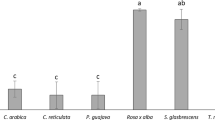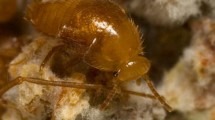Abstract
The workers of the leaf-cutting antAtta laevigata were found to mark a territory around their nest and along trunk trails. Elsewhere, we reported that the territorial mark had orientation and agonistic functions. The presence of this mark induced an alarm behavior in intruder workers and stimulated the residents' aggressiveness. Of the parts of the body tested, only the extracts from gaster or Dufour gland were able to induce the same agonistic behavior. The compoundsn-heptadecane, (Z)-9-nonadecene, 8,11-nonadecadiene, and (Z)-9-tricosene, secreted by Dufour gland were identified on foraging trails in the field as components of the territorial odor.
Similar content being viewed by others
References
Arnhart, L. 1923. Das Krallenglied der Honigbiene.Arch. Bienenk. 5:37–86.
Bazire-Benazet, M., andZylberberg, L. 1979. An integumentary gland secreting a territorial marking pheromone inAtta sp., detailed structure and histochemistry.J. Insect Physiol. 25:751–765.
Billen, J. 1984. Morphology of the tibial gland in the antCrematogaster scutellaris.Naturwissenschaften 71:324–325.
Billen, J. 1986. Etude morphologique des glandes tarsales chez la guêpePolistes annularis (L.) (Vespidae, polistinae).Actes Coloq. Ins. Soc. 3:51–60.
Billen, J. 1990. A survey of the glandular system of fire ants.In R.K. Vander Meer, K. Jaffe, and A. Cedeno (eds.). Applied Myrmecology: A World Perspective. Westview Press, Boulder, Colorado. In press.
Bradshaw, J.W.S.,Howse, P.E., andBaker, R. 1983. A novel pheromone regulating chain transport of leaves inAtta cephalotes. Anim. Behav.
Cammaerts, M.C., Morgan, E.D., andTyler, R.C. 1977. Territorial marking in the antMyrmica rubra L. (Formicidae).Biol. Behav. 2:263–272.
Carlson, D.A., Mayer, M.S., Silhacek, D.L., James, J.D., Beroza, M., andBierl, B.A. 1971. Sex attractant pheromone of the house fly, isolation, identification and synthesis.Science 174:76.
Evershed, R.P., andMorgan, E.D. 1980. A chemical study of the Dufour glands of two Attine ants.Insect Biochem. 10:81–86.
Evershed, R.P., andMorgan, E.D. 1981. Chemical investigations of the Dufour glands contents of Attine ants.Insect Biochem. 11:343–351.
Funes, A., Sanchez-Medina, F., andMayor, F. 1973. Terpene composition ofPinus pinaster seedlings and plants.Phytochemistry, 12:1391–1394.
Hölldobler, B., andWilson, E.O. 1986. Nest area exploration and recognition in leaf cutting ants (Atta cephalotes).J. Insect Physiol. 32:143–150.
Jaffe, K. 1979. Chemical communication among workers of leaf-cutting ants (Hymenoptera: Formicidae). PhD thesis. University of Southampton, 183 pp.
Jaffe, K., andSanchez, C. 1984. On the nestmate recognition system and territorial marking behaviour in the antCamponotus rufipes.Insectes Soc. 31:302–315.
Jaffe, K., Bzaire-Benazet, M., andHowse, P.E. 1979. An integumentary pheromone secreting gland inAtta sp.: Territorial marking with a colony-specific pheromone inAtta cephalotes.J. Insect Pysiol. 25:833–839.
Lensky, Y., andSlabezki, I. 1981. The inhibiting effect of the queen bee (Apis mellifera L.) footprint pheromone on the construction of swarming queen cups.J. Insect Physiol. 27:313–323.
Lensky, Y., Cassier, P., Finkel, A., Delorme-Joulie, C., andLevinsohn, M. 1985. The fine structure of the tarsal glands of the honeybeeApis mellifera L. (Hymenoptera).Cell Tissue Res. 240:153–158.
Malosse, C. 1990. A simple and efficient fraction collector for micropreparative capillary gaschromatography.J. High Resol. Chromatogr. 13:784–785.
Pasteels, J.M., Crewe, R.M., andBlum, M.S. 1970. Etude histologique et examen au microscope électronique à balayage de la glande sécrétant la phéromone de piste chez deuxCrematogaster nord-américains (Formicidae: Myrmicinae).C.R. Acad. Sci. 271D:835–838.
Porter, S.D., andBowers, M.A. 1982. Caste partition survivorship and route fidelity of leafcutting ant workers. M.D. Breed, C.D. Michener, and H.E. Evans (eds.).In The Biology of Social Insects. Proceedings, Ninth Congress IUSSI, Boulder, Colorado.
Salzemann, A., andJaffe, K. 1990. On the territorial behaviour of field colonies of the leafcutting antAtta laevigata (Hymenoptera: Myrmicinae).J. Insect Physiol. 36:133–138.
Salzemann, A., andJaffe, K. 1991. Dynamique du marquage territorial chez la fourmi champignonnisteAtta laevigata. Insectes Soc. In press.
Stork, N.E. 1983. How does the housefly hold on to your window?Antenna 7:20–23.
Vilela, E.F. 1983. Behaviour and control of leaf-cutting ant (Hymenoptera: Attini). PhD thesis. University of Southampton, 209 pp.
Walker, G., Yule, A.B., andRatcliffe, J. 1985. The adhesive organ of the blowfly,Calliphora vomitoria: A functional approach (Diptera: Calliphoridae).J. Zool. London 205:297–307.
Author information
Authors and Affiliations
Rights and permissions
About this article
Cite this article
Salzemann, A., Nagnan, P., Tellier, F. et al. Leaf-cutting antAtta laevigata (Formicidae: Attini) marks its territory with colony-specific dufour gland secretion. J Chem Ecol 18, 183–196 (1992). https://doi.org/10.1007/BF00993752
Received:
Accepted:
Issue Date:
DOI: https://doi.org/10.1007/BF00993752




